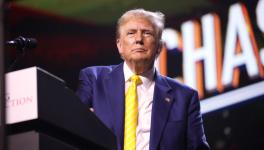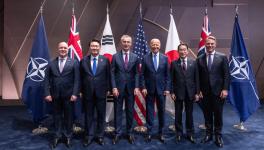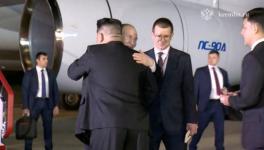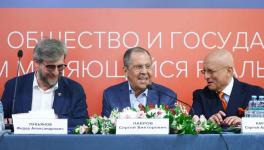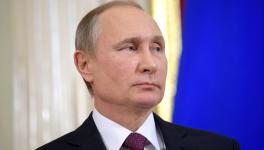Biden White House Spoofs the Kremlin
US President Joe Biden (R) and aides talking with Russian president Vladimir Putin, December 7, 2021
This must be a rare occasion when Russian President Vladimir Putin during his 18 years in the Kremlin came out second best in an encounter with an American president. And it had to be at the hands of President Joe Biden who has not yet completed one year in office. Yet, Putin has met with every sitting American president since Bill Clinton, in dire circumstances filled with awkward silences, icy stares and even professions of trust.
The Kremlin officials apparently misread the tea leaves and betted on a high probability that Putin and Biden would strike a deal at one-to-one level over Russia’s “red lines” in Ukraine — no NATO membership for Ukraine, no western deployments close to Russian borders.
Last Wednesday, Putin spelt out what the Kremlin was expecting at the talks. Speaking at a Kremlin ceremony, Putin emphasised that Russia will seek “reliable and long-term security guarantees.”
“In a dialogue with the United States and its allies, we will insist on working out specific agreements that would exclude any further NATO moves eastward and the deployment of weapons systems that threaten us in close vicinity to Russian territory,” Putin said.
He charged that “the threats are mounting on our western border,” with NATO placing its military infrastructure closer to Russia and offered the West to engage in substantive talks on the issue, adding that Moscow would need not just verbal assurances, but “legal guarantees.”
But Putin didn’t get any of that. He didn’t even get a one-on-one with Biden. The Russian state media reported that “the two leaders were expected to continue the video call one-on-one” after the photo-op, and Putin duly had his interpreter sit in a separate room to adhere to strictly one-on-one format, but only to discover later that Biden had company — the White House photo released after the call showed the interpreter, as well as Secretary of State Antony Blinken, National Security Advisor Jake Sullivan, and NSC’s senior director for Russia Eric Green sitting in the Situation Room alongside the president.
The mix-up is emblematic of the Kremlin’s misreading of what to expect at the meeting and its amnesia that the US strategy toward Ukraine is not really about Ukraine at all — it has never been — but has always been about containing Russia.
The press briefing given by Biden’s NSA Sullivan underscored that in a “direct and straightforward” manner, the following message has been given to Putin:
A. If Russia escalates its build-up or threatens Ukraine, the US and its European allies
- will respond with harsh, unprecedented, punitive economic sanctions;
- will “provide additional military supplies to Ukraine above and beyond what are already being provided;
- would fortify the NATO Allies on the eastern flank with additional capabilities in terms of both military supplies as well as the additional deployment of assets and capabilities.
B. The US arms supplies to Ukraine will continue and may even be enhanced depending on how circumstances evolve.
C. Washington will use Nord Steam 2 gas pipeline to leverage Moscow’s behaviour, “because if Vladimir Putin wants to see gas flow through that pipeline, he may not want to take the risk of invading Ukraine.”
D. Biden is not making “idle threats.” Circumstances are very different from 2008 when “Putin, standing behind then-President Medvedev in 2008, invaded Georgia,” because at that time the US was preoccupied with Iraq and Afghanistan.
E. However, there is an alternate pathway for Russia — “de-escalation,” in which case,
- Washington and its allies would engage in a discussion with Moscow over larger strategic issues of concern to both sides as in the Cold War era and develop “mechanisms to help reduce instability and increase transparency”;
- the US would also be prepared to support efforts to advance the Minsk Agreement, including ceasefire and confidence-building measures.
Sullivan said the US is planning for all contingencies — “specific, robust, clear responses” to any Russian escalation.
As regards Putin’s red lines on Ukraine’s NATO membership and legal guarantees thereof, Sullivan emphasised that Biden “made no such commitments or concessions. He stands by the proposition that countries should be able to freely choose who they associate with.”
On the other hand, the Western offer to talk to Russia about strategic issues in the European theatre was on the table. “What the right mechanism for that is, what the agenda for that is, and what comes of that — that is all to be worked out as we see how things proceed in the coming days.”
To be sure, Sullivan’s grandstanding was with an eye on the domestic audience. Nonetheless, what comes through his tough talk is that the US and Russian positions remain far apart, almost diametrically opposite to each other.
The Kremlin readout throws some hints that in his response, Putin “warned against shifting the responsibility on Russia, since it was NATO that was undertaking dangerous attempts to gain a foothold on Ukrainian territory, and building up its military capabilities along the Russian border. It is for this reason that Russia is eager to obtain reliable, legally binding guaranties ruling out the eventuality of NATO’s eastward expansion and the deployment of offensive weapons systems in the countries neighbouring Russia.”
The readout claimed that Putin and Biden “agreed to instruct their representatives to engage in meaningful consultations on these sensitive matters.”
The entire briefing by Sullivan was scripted in such a way to target Putin personally. Sullivan’s language was barely respectful. He talked as if Putin is facing an inquest.
The Biden team set up this meeting on the last day of German Chancellor Angela Merkel in office. The face-off with Russia is being cynically exploited to reassert the US’ transatlantic leadership at a juncture when the German-French axis is transitioning.
By creating a narrative counting in binary — escalation versus de-escalation — US has positioned itself in a “win-win” situation. Russia’s agenda has never been to invade Ukraine but only to make its red lines clear and draw the US into a dialogue.
The demand for “de-escalation” is preposterous because Russia’s deployments are only on its territories, and that too, at a distance over 200 kilometres from the Ukraine border.
But by deliberately flaring up tensions, the US has strengthened its own position to advance the western presence, especially NATO’s, in Ukraine and let Moscow see what it should expect if the situation deteriorates.
That is to say, the burden of “de-escalation” now falls solely on Russia’s shoulders. The ball is now in Russia’s court and the Kremlin needs to show its ability to respond to the US allegations. Fundamentally, the Ukraine issue and NATO expansion can trigger a new crisis.
Moscow’s demands of legally binding guarantees against NATO’s eastward expansion are reasonable, given the unfulfilled Western assurances in this regard to Mikhail Gorbachev over thirty years ago and, of late, Russia’s concerns over Kiev’s provocative actions against Donbas as well as the western alliance’s use of Ukrainian territory for military purposes.
The crux of the matter is that the US will continue to use NATO as the main tool to deter Russia, while trying to turn Ukraine into an anti-Russian state right on its western border. If the US continues to push for NATO expansion, increasingly threatening Russia, Moscow is bound to take counter-measures. That may be only a matter of time.The coming few weeks are going to be crucial.
Get the latest reports & analysis with people's perspective on Protests, movements & deep analytical videos, discussions of the current affairs in your Telegram app. Subscribe to NewsClick's Telegram channel & get Real-Time updates on stories, as they get published on our website.











